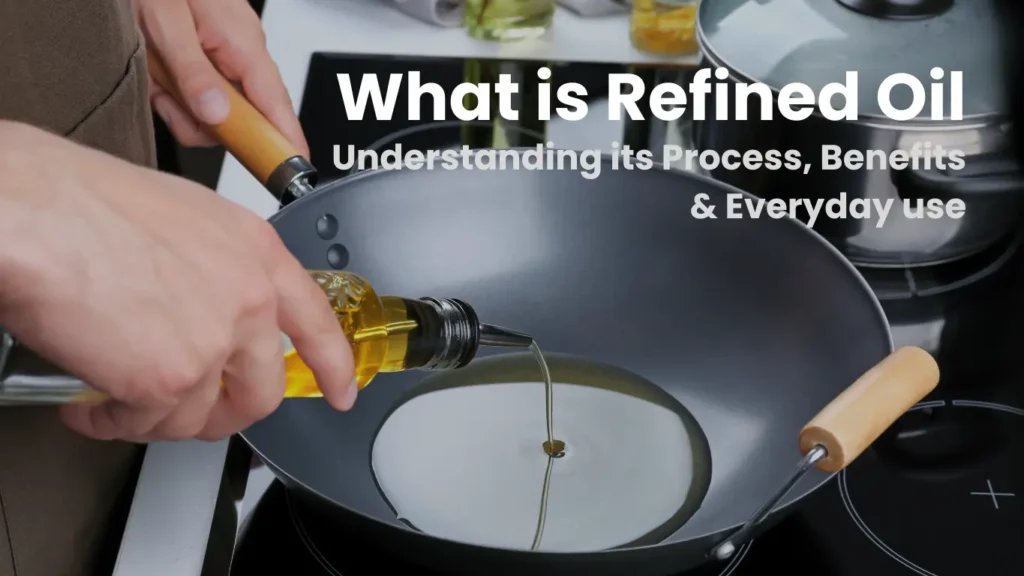
If you’ve ever picked up a bottle of sunflower, soybean, or canola oil at the supermarket, chances are it’s a refined oil. But what exactly does that mean? Is refined oil healthier, or should you be reaching for “cold-pressed” and “unrefined” options instead?
Let’s break it down.
Refined oil is one of those kitchen essentials that quietly shapes your meals — from the crispness of your fries to the texture of your baked goods. Yet, few people truly understand how it’s made, what sets it apart, and how it affects your health.
This blog will help you understand what is refined oil, how it’s produced, its benefits and drawbacks, and when it’s the right choice for your cooking needs.
What Is Refined Oil?
In simple terms, refined oil is edible oil that has undergone a series of purification processes to remove impurities, odor, color, and unwanted compounds. The goal is to make the oil more stable, longer-lasting, and suitable for various cooking applications — especially at high temperatures.
While unrefined oils retain their natural flavor and nutrients, refined oils are treated to ensure a neutral taste, clear appearance, and higher smoke point. That’s why most packaged oils you find in restaurants and households are refined.
The Refining Process Explained
To understand what is refined oil, you need to know what happens behind the scenes. The refining process can be mechanical or chemical, and typically follows these key stages:
1. Degumming (R)
Natural gums and phospholipids are removed from crude oil to improve texture and shelf life.
2. Neutralization (B)
Alkalis are added to remove free fatty acids (FFAs), which can cause rancidity.
3. Bleaching (D)
Activated clay or charcoal is used to eliminate pigments, resulting in a lighter, golden color.
4. Deodorization (W)
Steam distillation removes any residual odors and flavors, giving the oil a neutral aroma and taste.
5. Winterization (Optional)
This step prevents cloudiness when oils are refrigerated — especially important for salad dressings or bottled oils.
At the end of these stages, you get a smooth, odorless, light-colored oil ready for commercial packaging.
Refined Oil vs. Unrefined Oil
| Feature | Refined Oil | Unrefined Oil |
|---|---|---|
| Processing | Chemically or mechanically treated | Cold-pressed or expeller-pressed |
| Color & Aroma | Clear, neutral | Natural color and aroma |
| Nutrient Content | Some nutrients may be lost | Retains most vitamins and antioxidants |
| Shelf Life | Long | Shorter |
| Smoke Point | Higher (400–500°F) | Lower (250–375°F) |
| Best For | Frying, baking, and commercial cooking | Salads, dressings, light sautéing |
Here’s the catch: while unrefined oils preserve nutrients, they’re less stable at high heat. Refined oils, on the other hand, handle deep frying and sautéing like a pro — making them essential in most kitchens.
Why Refined Oil Is So Common in Cooking
1. High Smoke Point
Refined oils don’t burn easily. This means you can deep fry or stir-fry without your kitchen filling with smoke.
2. Longer Shelf Life
Thanks to purification, refined oils last much longer on shelves without turning rancid.
3. Neutral Taste
No overpowering aroma — making them versatile for different cuisines, from Indian curries to continental dishes.
4. Affordability
Refined oils are easier to produce at scale, so they’re more affordable compared to cold-pressed oils.
Health Aspects: Is Refined Oil Healthy?
This is where the debate begins.
Refined oils aren’t inherently “bad,” but excessive processing can strip away natural antioxidants, vitamins (like E and K), and phytosterols that support heart health. Some low-quality refining methods may also introduce trace contaminants if chemicals are used improperly.
The Good
Ideal for high-temperature cooking.
Affordable and easily available.
Neutral taste that doesn’t overpower food flavors.
The Concerns
Loss of some nutrients and antioxidants.
Possible presence of trans fats in poorly refined oils.
Overconsumption can affect cholesterol levels.
Pro Tip
Look for expeller-pressed or mechanically refined oils. These are processed without harmful chemicals and retain more nutrients. Always check labels for terms like organic refined, non-GMO, or cold-filtered.
How to Choose the Right Refined Oil
Not all refined oils are equal. Choosing the right one depends on your cooking style, flavor preferences, and health goals.
1. For Deep Frying
Sunflower oil, canola oil, and rice bran oil are excellent due to their high smoke points.
2. For Everyday Cooking
Soybean oil or refined olive oil (light olive oil) offers versatility.
3. For Baking
Refined coconut oil provides structure without imparting a strong flavor.
4. For Heart Health
Opt for refined mustard oil or rice bran oil, known for their good fatty acid balance.
When buying, always go for brands that disclose their refining process and quality certifications.
Cost & Market Trends
Refined oils dominate the global edible oil market, valued at over $240 billion in 2024. In India, the demand continues to grow due to changing dietary patterns and affordability.
However, consumer awareness is shifting — people now seek transparency, natural extraction methods, and sustainable sourcing. This has led to a rise in mechanically refined oils and organic variants.
For reference, check out U.S. Department of Agriculture’s guidelines on edible oil standards — a trusted authority in global food safety and oil processing norms. (External Source: USDA.gov)
The Future of Refined Oils
The next decade will redefine how we perceive refined oils.
We’re witnessing a wave of innovation in sustainable oil refining, including:
Green refining technologies that use water-based methods instead of harsh solvents.
Nutrient-retentive refining to preserve vitamins and polyphenols.
Bio-based packaging to reduce carbon footprint.
Imagine refined oils that are both clean and nutritious — that’s where the future is headed.
Final Thoughts
So, what is refined oil in the grand scheme of your kitchen? It’s a practical, versatile, and stable oil choice that supports a wide range of cooking needs. While unrefined oils shine in nutrition and flavor, refined oils excel in performance, affordability, and convenience.
The key lies in moderation and quality. Choose oils that are mechanically refined, non-GMO, and certified organic to strike the perfect balance between health and taste.
FAQs
1. What is refined oil used for?
Refined oil is used for frying, sautéing, baking, and other high-heat cooking applications due to its high smoke point and neutral flavor.
2. How is refined oil made?
Refined oil is made by purifying crude oil through degumming, bleaching, deodorizing, and sometimes winterizing to remove impurities and odors.
3. Is refined oil bad for health?
Not necessarily. Refined oils are safe when consumed in moderation, but overconsumption or use of low-quality variants may lead to health issues.
4. What is the difference between refined and unrefined oil?
Refined oils are processed to remove impurities and odors, while unrefined oils are minimally processed and retain natural flavor and nutrients.
5. Can refined oil be organic?
Yes, organic refined oils exist — they’re mechanically processed without chemicals while meeting organic farming standards.
6. Which refined oil is best for frying?
Sunflower, canola, and rice bran oils are great for frying because of their high smoke points and neutral flavor.
7. Does refined oil contain trans fats?
Most modern refined oils contain little to no trans fats, especially if they’re mechanically refined. Always check the label.
8. Is refined oil better than cold-pressed oil?
It depends on usage — refined oil is better for high-heat cooking, while cold-pressed oil is ideal for salads and low-heat dishes.
9. Can refined oil go bad?
Yes, even refined oils can become rancid over time. Store them in cool, dark places and use before their expiry date.
10. Why does refined oil look clearer than unrefined oil?
Refined oil undergoes bleaching and deodorizing, which remove pigments and particles, giving it a transparent appearance.

